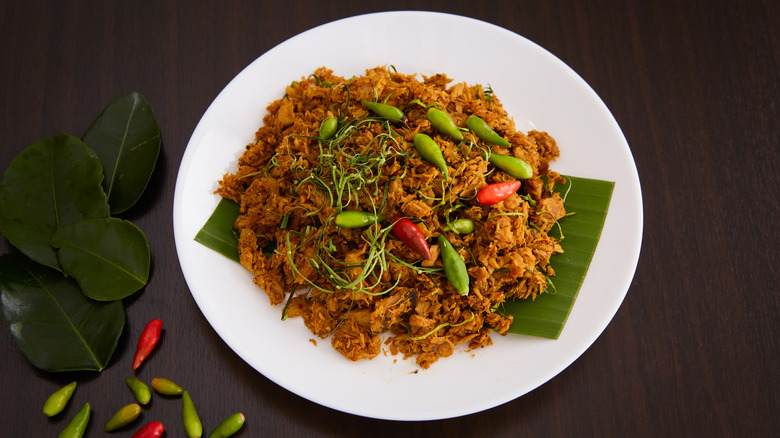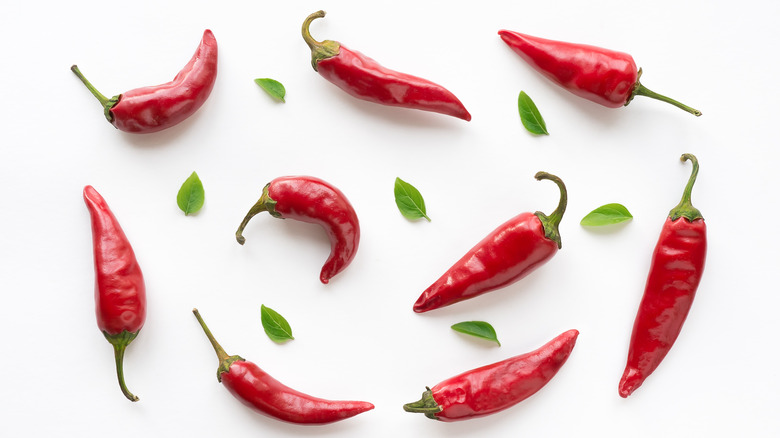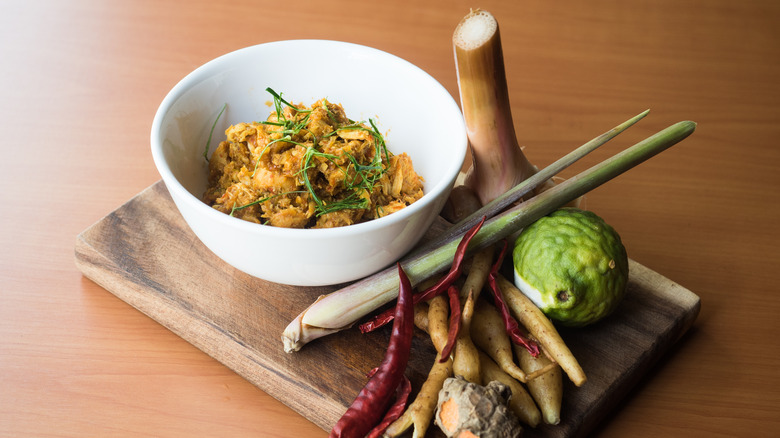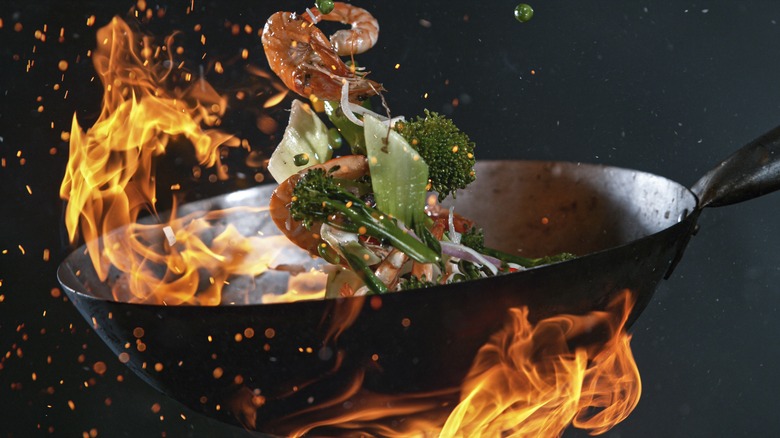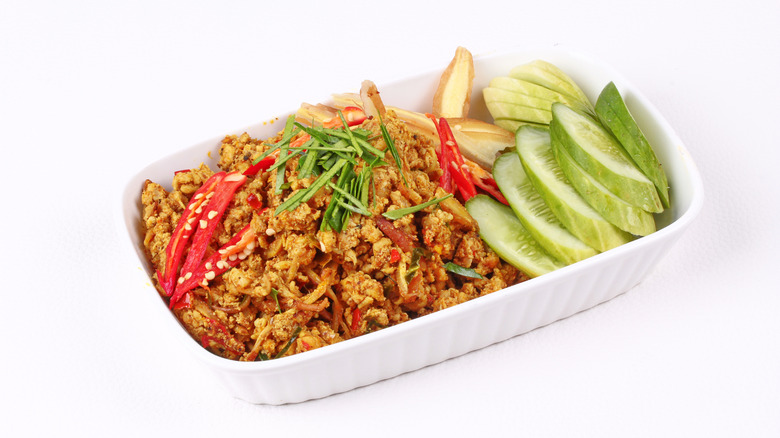Khua Kling Gai: Southern Thailand's Dry Chicken Curry
Pad thai is often one of the first things that come to mind when one thinks of Thai food. But the cuisine extends way beyond this, as many dishes showcase a contrast between spicy, sweet, and citrus ingredients. Compared to other Asian dishes, Thai food is often described as "layered" since there are many of the above elements in each dish, but they all seem to work cohesively and balance each other out. One of these dishes is known as khua kling gai, and it's perfect for those who live for spicy meals.
Khua kling gai, according to the Michelin Guide, is a dry curry of meat and Thai chiles that are stir-fried together. Its flavors are spicy, well-balanced, and fresh, which pairs well with rice, Thai omelets, Panang curries, and vegetables, per Serious Eats. Eating Thai Food explains that this dish is quite popular in southern Thailand and can be made using any kind of meat. "Gai" actually means chicken (per The Spruce Eats), while "khua" refers to dry roasting. So for instance, you could make khua kling mŏo instead of gài, which means the dish has pork in it.
There's also little to no sauce in this dish. Sure, some fish sauce, oil, and southern Thai curry paste are used, but as Serious Eats explains, everything gets dried out and the chicken and curry paste combine together harmoniously.
How spicy is khua kling gai?
Well for starters, Thai chili peppers are between 50,000 to 100,000 on the Scoville scale, which means it's hotter than cayenne and jalapeño peppers, but not as hot as habanero and ghost peppers, via Spicy Food Reviews. Another source of heat comes from the prik gaeng pak dtai, aka southern Thai curry paste. A separate Serious Eats source explains that this curry paste is made from dried Thai chiles, fresh red Thai chiles, Thai shrimp paste (which may be spicy depending on the brand), and other spices and seasonings. In short, khua kling gai is spicy because there are Thai chiles in the meat mixture, as well as a curry paste made from Thai chiles (using a mortar and pestle).
Thai Table also notes that in Thailand, some dried chile peppers are way hotter than others and that's because of their size. Bigger chile peppers usually mean that the spice level is a little tamer while smaller peppers are packed with a spicier punch.
What are the ingredients in khua kling gai?
Aside from boneless skinless chicken thighs, fresh Thai chile peppers, and southern Thai curry paste, Punchfork lists a few other ingredients, namely, vegetable oil, sugar, fish sauce, lemongrass, and makrut lime leaves (fresh or frozen will work).
As previously mentioned, khua kling gài is spicy, well-balanced, and fresh, but why is this so? Well, the spice levels have already been discussed, but the "well-balanced" aspect comes from the fish sauce and sugar. Fish sauce, as explained by Lacademie, is fishy, umami, and salty, while sugar is, of course, sweet. So far, the dish sounds like a party in the mouth with spicy, sweet, salty, and savory flavors.
Serious Eats notes that the fresh and herbal flavors of khua kling gài is due to the lemongrass, makrut lime leaves, and fresh Thai chiles. Foodiosity describes lemongrass as "citrusy" with a "strong vegetal, earthy flavor" that bears some small resemblances to lemons. Makrut lime leaves makrut limes, which are found in some parts of southeast Asia and southern China, per US Citrus. It has a "bright citrus flavor" and is very aromatic, enhancing cuisines across Malaysia, Indonesia, Vietnam, and Thailand alike. So not only does khua kling gài have elements of freshness and herbaceousness, but citrus and earthy flavors as well.
How is khua kling gai prepared?
First, you're going to start with minced boneless skinless chicken thighs and sliced makrut lime leaves, lemongrass (the bottom part), and fresh Thai chile peppers, per Serious Eats. The peppers should be stemmed and sliced "crosswise on a bias." ½-inch slices work best here. Eating Thai Food suggests shaving the lemongrass and lime leaves finely for softer textures and more pronounced flavors.
After the prep work is done, Serious Eats adds two tablespoons of vegetable oil to a hot wok and then two tablespoons of the southern Thai curry paste. These are cooked and stirred together for about 30 seconds before ½ pound of the chicken is added. (Note: Eating Thai Food states that no oil is necessary when making this dish because of the "dry" aspect of this dry curry. But About Olive Oil explains that when protein and the surface of a pan interact without any oil as a barrier, sticking may take place.)
The next step involves cooking the chicken in the oil and curry paste mixture. It's important to keep stirring the chicken so it won't stick to the wok, which should be scraped as well. Eventually, the moisture levels should subside and the chicken should be cooked. Afterward, sugar and fish sauce are added and cooked for roughly 30 seconds, which is then joined by the lemongrass, makrut lime leaves, and chile peppers. These are all tossed together for a bit and then served with various side dishes.
Khua kling variations
As previously mentioned, khua kling can be made with any kind of meat since the term "khua kling" refers to the dish as a whole rather than the particular meat in it. So theoretically, you could have khua kling gûng, khua kling néua wua, or even khua kling haem, which are shrimp/prawns, beef, and ham, respectively (vocabulary defined by Transparent Language).
If you're not a meat eater, this dish can be made using crumbled tempeh (per Thaifooding). Tempeh, as told by America's Test Kitchen, acts like a sponge that takes on flavors from other seasonings, sauces, and ingredients (much like tofu). It's also soy-based and looks like a small rectangular "cake" that works as a substitute for meat. Soy-free variations are available as well.
Aside from meat or tempeh, ingredients may also vary depending on the recipe. For instance, Taste Atlas notes that shrimp paste, coriander, turmeric, and galangal (which is a rhizome that's zesty and peppery, per The Spruce Eats) can be incorporated into khua kling.
By now, it should be apparent that khua kling welcomes all kinds of proteins and highlights contrasting flavors that emphasize the term "layered" in Thai cuisine. It's savory, spicy, fresh, a little bit sweet, and well worth an attempt in the kitchen (or at the very least, ordering one at a Thai restaurant).
